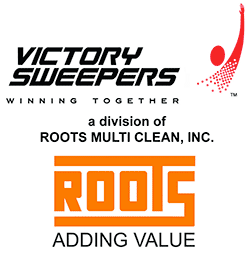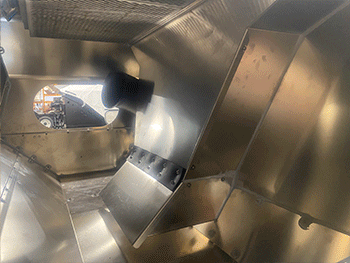Sweeping Industry News Bulletin |
|
August, 2022 Making a Case for Aluminum Sweeper Hoppers – The Time is NowVictory Sweepers' Mark Schwarze discusses the advantages he believes aluminum hoppers provide for use on some models of parking area sweepers.

by Mark Schwarze, Product Development Manager, Victory Sweepers
Part of my role at Victory Sweepers is to continually evaluate what we can do to keep costs down for our customers. During this process, while reviewing the repair and upkeep needs regarding the standard aluminum hoppers on our Mark I sweepers starting in 2008, we realized there had been very few issues that cropped up regarding them. Plus, the few issues that had surfaced were easily remedied.
Those sweeper manufacturers – and their customers – are now finding there are rust-through issues with that product. Plus, this lower echelon grade of stainless still weighs the same as the premium 304 stainless Victory still uses. The potential advantages in using the aluminum made today are many. Although there is no question stainless steel is stronger than aluminum, it weighs about three times as much. That means an aluminum hopper provides a weight savings of about 600 pounds per sweeper. In some instances, this creates a higher payload while sweeping. In others, it means a lighter chassis may be used, which can provide a significant cost savings for the overall sweeper unit. Even though stainless steel is stronger overall, aluminum offers a much better strength-to-weight ratio. This allows aluminum hoppers to be made slightly thicker than stainless steel, which increases overall durability. Stainless steel does have a much better resistance to heat than does aluminum, but heat is not an issue with sweeper hoppers. Cold temperatures can be, though, which is another area where aluminum has an advantage over steel. As the temperature decreases, the tensile strength of aluminum increases. By contrast, steel becomes brittle in cold temperatures. Unlike steel, aluminum does not rust. However, it does oxidize when exposed to salt. Rather than wearing out like steel or "somewhat stainless" steel – both of which weaken when flakes of rust form and then slough off the metal – aluminum oxide merely creates a hard, whitish colored, surface skin. This happens when the aluminum atoms on the outside surface bond with oxygen, a process that fortunately stops once all of the aluminum atoms on the outer surface have created a bond.
Some grades of aluminum, notably 5052 and 3003, have better corrosion-resistant properties than do the others. That's why it's important to find out the grade of aluminum used in the hopper of any sweeper you're considering – or when purchasing any other product where corrosion might be an issue. Our testing has shown that 5052 grade aluminum also has a higher strength-to-weight ratio than the other grades. Another plus is that it is easier to form, which allows us to shape the material as easily as stainless or carbon steel. That's why, at Victory Sweepers, we use 5052 as our standard grade of aluminum when building hoppers. As previously mentioned, Victory first introduced aluminum hoppers in 2008 on our single-engine Mark I model. We did it to minimize weight, choosing that model because single-engine sweepers typically have less power. However, it turned out that our engineering gurus designed the machine so well that it would pick up a brick, negating that argument. Now, after 14 years of experience with identifying any potential problems with the Mark I's aluminum hopper the most notable issues have been areas of concentrated air blast. This caused a few aluminum hoppers to develop a dump door issue after several years of service. Our easy fix was to design a rubber flap that protects the door. The only other issue was cracking in the aluminum where the dump door hinges bolted directly to the hopper. This turned out to be an issue with electrolysis, which is when an electrical current passes between dissimilar materials, in this case between the hinge and the door's pivoting rod. The same type of problem has occurred with some stainless hoppers. By designing a new hinge, one that is grease-able and equipped with a liner on its internal pivoting wear area, the issue was solved on both. Should hoppers on the most powerful class of sweepers be made of aluminum? In my opinion, no. Due to larger hopper sidewall dimensions and the greater power of street-class sweepers, along with the extreme sweeping conditions some encounter, we believe aluminum is not yet suitable for those. However, aluminum hoppers make perfect sense for many parking area sweeper models. An aluminum hopper is now standard on Victory's GX-12, DF-12 (and upcoming UNO) models, as well as optional on our GX. With an aluminum hopper, the GX can then be mounted onto a 12,000 GVWR chassis instead of the more costly 14,500 GVRW chassis. Taking a cautionary stance, we will not be offering an aluminum option on our DF, DX or MARK III models due to the extreme conditions that these super high performance sweepers may see. Although we may decide to do so in the future, we want to be certain before taking that step. Because aluminum is lightweight, corrosion-resistant, and offers a high strength-to-weight ratio, the metal is being used increasingly in the automotive, aerospace and space industries. The new Ford F-150s – America's #1 selling truck – have aluminum body components, including doors, hoods and even the truck bed. Some train rails are even being made of aluminum these days. Aluminum is also being used in high-rise buildings in more areas due to its positive track record in those over time – fun fact: the Empire State building, built in 1931, was one of the first structures to contain aluminum. After 14 years of monitoring a somewhat astonishing lack of issues with hoppers made of aluminum, at Victory Sweepers we are confident that specifying an aluminum hopper on many models of parking area sweepers is a very good fit. Doing so can provide a savings of at least $5000 on new sweeper purchases with virtually no long-term downside. If an aluminum hopper allows the use of a smaller GVWR chassis the savings become even more. In closing, we think now is the time for using aluminum wherever it makes sense. When specified on the correct models, doing so provides a win — win situation for all. Mark Schwarze is the son of the founder of Schwarze Industries, Inc., and has been involved in the business of manufacturing sweepers for 48 years. He was president of Schwarze Industries from 1986 to 2002. Schwarze Industries was sold to the Alamo Group in 2000. Today he is the marketing director and product development manager for Victory Sweepers. Reach Victory toll-free, at 844-4-SWEEPER (844-479-3373). You may also send email to Mark Schwarze at mschwarze@ victorysweepers.com. If you have a question or comment about this article, please let us know. If appropriate, we'll add it to the bottom of this page. |
© 2005 - 2022
|
Industry Updates Contents
|